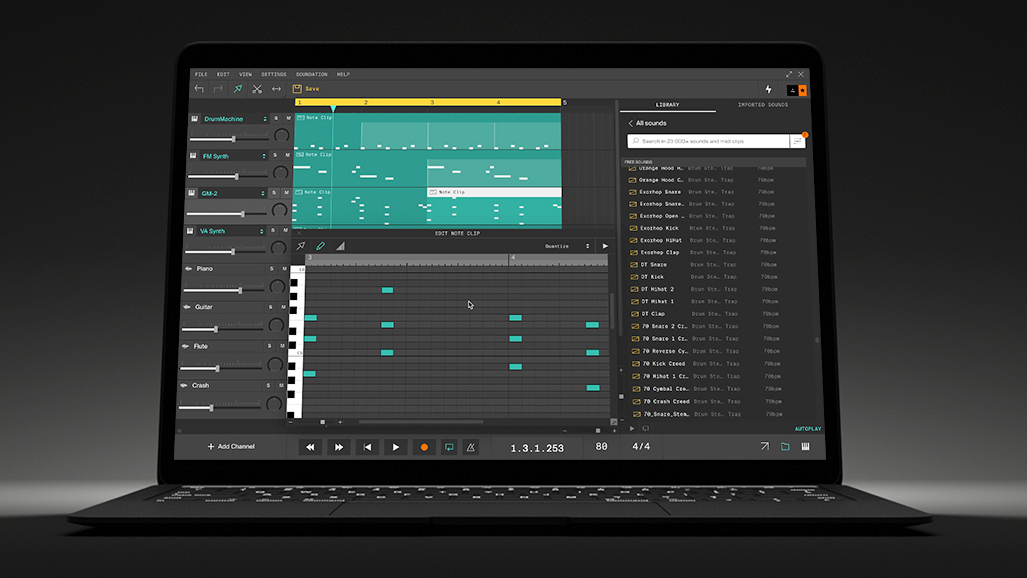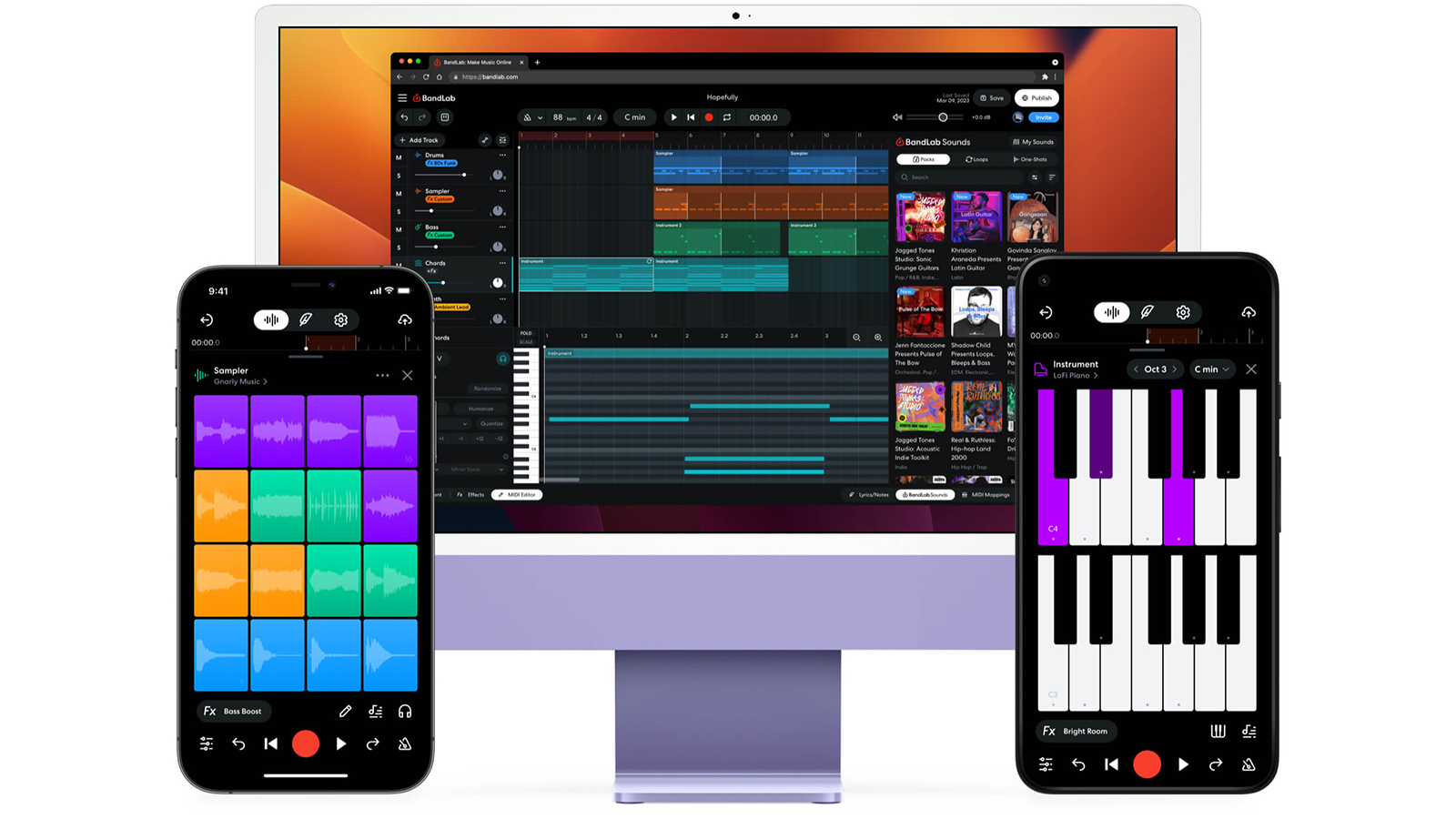
Digital Audio Workstations (DAWs) have long been the backbone of modern music production. Traditionally, producers and musicians have relied on offline DAWs like Ableton Live, Logic Pro, and FL Studio to craft their sound. Speaking personally, I’ve used them all. From Cool Edit Pro back in my broadcast days, to testing out everything from Live to Logic, via standalone Maschine, Korg’s nifty Gadget app and the classic Music 3000 on my trusty PlayStation 2.
However, the rise of browser-based DAWs has introduced an entirely new way of working, and one that’s fast gaining traction. Thanks to my 15-year-old son’s growing interest in music production, I've seen it myself. Whereas traditionally many budding producers would start (and indeed, some remain) mapping drum parts and playing with wild synth leads in the veteran DAW FL Studio (or Fruity Loops, if you’re old like me), graduating later to more serious options once they’ve learned their fundamentals, many in his generation are choosing a different gateway altogether.
This article will explore the differences between offline and online DAWs and the key benefits of online tools, and introduce some of the most respected browser-based platforms. Are traditional DAWs at risk of losing ground, or can both approaches coexist harmoniously?
How DAWs are typically used: the offline approach
For years, DAWs such as Ableton Live, Logic Pro, and Pro Tools have dominated the music production landscape. These desktop-based applications are rich in features, offering unparalleled control over audio manipulation, MIDI programming, sound design and mixing. Producers use them to compose entire tracks from scratch, recording and editing audio, arranging compositions, and applying effects before mixing and mastering the final product. In many ways they’ve democratised music production, simplifying the process by making it much more visual and intuitive. If you’ve got a laptop, you can be a producer.
Offline DAWs offer a high degree of customisation and are the industry standard for professionals because of their depth, flexibility, and performance capabilities. Ableton Live, for example, is widely beloved for its intuitive interface and unique Session View, which enables live looping and creative experimentation on the fly. The depth of Ableton's workflow, alongside its vast library of instruments, effects and MIDI control, makes it a go-to for both electronic musicians and live performers. And, once you’ve run through the initial licence process, you don’t need an internet connection again.
However, using these powerful tools can come with trade-offs. They require significant processing power, plenty of storage, and high-end audio interfaces to handle demanding projects. Collaboration between musicians in different locations is often cumbersome, requiring the export of project files or stems and heavy reliance on file-sharing platforms. Frequent manual saving is also necessary, increasing the risk of lost progress if a system crashes or if files become corrupted. As production becomes more cloud-oriented, many are questioning whether desktop DAWs are beginning to show their limitations.
The benefits of online DAWs

In response to these limitations, a new wave of browser-based DAWs has emerged, offering producers a streamlined and more accessible way to create music. These platforms harness the power of cloud computing, running entirely within a web browser, which brings several significant benefits.
One of the primary advantages of online DAWs is that they require far fewer system resources than offline counterparts. Since the heavy lifting is done on cloud servers, users can run complex projects on more modest machines, including laptops, tablets, or even smartphones. We’ve seen them running on inexpensive Chromebook laptops, which you can pick up for just over $/£100. This opens the door to music production for people without access to expensive hardware, or those who need a more lightweight set-up.
Collaboration is another major strength of online DAWs. Unlike traditional offline DAWs, which rely on file exports and cumbersome emailing or sharing of project files, browser-based DAWs allow for real-time collaborative work. Multiple musicians can log into the same project from different locations, making tweaks, recording audio or editing arrangements simultaneously. This feature is particularly appealing for bands, remote production teams, or even casual users who want to jam with friends. I’ve seen my aforementioned 15-year-old working virtually on a project with his friends, with their cursors all visible, each crafting a different section of the song. One tweaking a drum loop in the intro, another adding effects to a chorus vocal part, and another mixing the track in real-time. A bit like being in an actual band, right?
Multiple musicians can log into the same project from different locations, making tweaks, recording audio or editing arrangements simultaneously
Another key benefit is auto-saving. Cloud-based DAWs automatically save your work as you go, similar to how a Google Doc works, significantly reducing the risk of losing hours of progress due to a computer crash or software glitch. For mobile producers or those working on the go, this can be a game-changer, offering peace of mind and seamless creative flow.
In short, browser-based DAWs combine accessibility, collaborative functionality, and convenience. They cater to musicians who need flexibility in their work environments and those looking for an intuitive and low-overhead approach to production.
My pick of online DAWs
As browser-based DAWs continue to mature, several have gained recognition in the industry for their innovation, ease of use, and quality. Here’s a quick rundown of a few popular options.

Soundation is an excellent choice for beginners and casual producers. With a drag-and-drop interface and a variety of built-in loops, instruments, and effects, it’s simple to start creating music right away. Soundation also includes real-time collaboration features, making it easy for groups to work together in different locations.

BandLab is one of the most popular free DAWs for online users, offering a wide range of tools and a built-in social platform for musicians to share and promote their work. Its interface is intuitive, making it a great option for newcomers, while its cloud-based storage system allows for seamless collaboration across devices.

Soundtrap has garnered attention for its blend of accessibility and advanced features, offering a versatile platform for both beginners and intermediate producers. It includes a wide array of virtual instruments, loops, and effects, alongside built-in podcasting tools, making it a favourite for multimedia creators.

Amped Studio is designed with both beginners and more experienced producers in mind. It offers real-time collaboration, support for VST plugins, and MIDI functionality, which sets it apart from some other browser-based DAWs. It’s ideal for producers who want the flexibility of working in the cloud while still accessing advanced tools.
Conclusion
So who exactly are online DAWs best suited to? Fundamentally, online DAWs offer significant advantages for a variety of users. They’re especially beneficial for those who need a flexible, low-cost, and lightweight music production solution. For beginners or casual creators, the user-friendly nature of these platforms makes them an excellent starting point. Once you become proficient with any traditional DAW, you’ll find the skills transferable across most (or all) of them, but each has its steep learning curve. Learn your trade on a simple online system and you should, in theory, find it easy to level up to something more complex, or with more depth to its capabilities. The collaboration features make music production – occasionally quite a lonely process for solo producers – much more social, and this in turn means they’re also ideal for bands, remote production teams, or creators working on group projects.
However, for seasoned professionals, traditional DAWs remain indispensable, thanks to their depth, precision, and flexibility. The sheer processing power of offline DAWs, their rich feature sets, and extensive plugin support are still unmatched in the online realm. Though online DAWs have come a long way, they aren't yet a direct threat to the dominance of heavyweights like Ableton or Logic Pro, which offer far greater depth for advanced production needs.
In the future, the growing appeal of cloud-based solutions could encourage traditional DAWs to incorporate more collaborative features, making hybrid workflows the norm. But for now, the choice comes down to the user's needs: for lightweight, flexible, and collaborative music-making, browser-based DAWs are a powerful, convenient alternative to the traditional giants.







